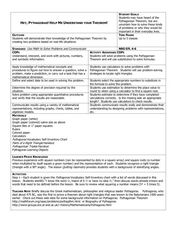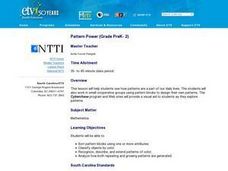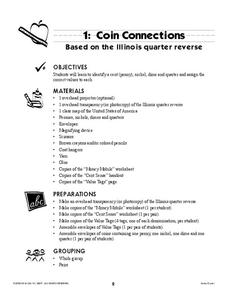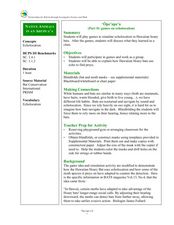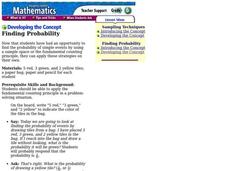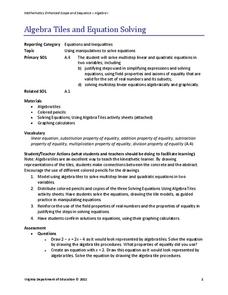Curated OER
Write the Word
Combine several concepts with youngsters, who will enjoy expressing their artistic side as they identify shapes and practice printing. First, scholars trace the word yellow and use this color to shade all the rectangles they...
DK Publishing
Stars and Planets Connect the Dots
Reach for the stars with this cute connect-the-dots activity! Kindergartners practice their counting and number sequencing by connecting the numbers 1 through 6 or 10 in four different shapes. A rocketship is completed for them as an...
Curated OER
Butterflies and Addition Sentences Worksheet
These butterflies need some color! Learners solve each of the nine single-digit addition problems to discover what color each butterfly will be according to the color key. The sums are between 1 and 10, and not all numbers will be used....
Curated OER
Understanding Visual Fractions
Using fractions as their artistic guide, learners color in parts of five shape images. Each image is segmented based on the denominator, so scholars simply need to apply the numerator to know how much to color. None of these are mixed...
Curated OER
Is Your Money Rolling Away?
Young scholars demonstrate how to solve word problems. They will watch the video "Math Can Take You Places" and identify three problem solving strategies.
Curated OER
Understanding Fractions
In this recognizing fractions worksheet, students observe explanations and examples of pie charts and bars and use them to color, write the fraction of the shaded part, and draw and color pie charts. They will solve thirty-two problems.
Curated OER
Bugs
This is not just a worksheet, but an entire set of activities and worksheets that can accompany any unit on bugs or insects. Little learners will hone early math and literacy skills as they create mini-books, discriminate between big and...
Richland County School District One
Falling Into Geometry Through Paper Art
New-to-school learners create a fall quilt consisting of three different paper geometric quilt squares. They use various geometric shapes that when assembled will form a scarecrow, pumpkin, and a crow. Assembly will require sorting...
Curated OER
Vegetable Print Patterns
Create a unique print using vegetable stencils and tempera paints applied to grid like pattern formed from cut pieces of paper. Your students will choose either a warm or a cool color scheme.
Curated OER
Hey, Pythagoras! Help Me Understand Your Theorem!
Learners explore the Pythagorean Theorem. In this math lesson, pupils solve problems using the Pythagorean Theorem. They select the appropriate numbers to substitute in the formula to solve problems.
Curated OER
Pattern Power
Young elementary students will discover there are patterns all around them in their daily lives. In groups, they sort pattern blocks by size and color. Using the internet, they create their own type of patterns and share them with the...
Curated OER
Create a Graph Online
Scholars create colorful bar, line, or pie graphs. They decide on a survey question to ask or a type of data to gather. From there, they collect information and data. They display this data in bar, line, or pie graphs that they create...
Curated OER
Coin Connections
A wonderful lesson on identifying the penny, nickel, dime, and quarter awaits your young mathematicians. They engage in a multi-session lesson which allows them to practice using the values of each coin in worksheets and activities...
DK Publishing
Number Sentences: Dividing by 4
Division can be a picnic! Given illustrations of picnic foods, such as sandwiches, drinks, and cupcakes, third graders practice their money math and division skills. Have them color the page when they're finished, or bring division to...
Curated OER
Games on Echolocation
Get a little batty with life science! This fun simulation game replicates how bats use echolocation to hunt moths in their native Hawaiian habitat. After creating blind folds and discussing some basic principles of echolocation, students...
DK Publishing
The Missing Numbers
Where are all the numbers? Scholars practice with number sequences in different formats as they fill in numerals. First, an analog clock face is missing four numbers. Next, they write in the next four digits in a single-digit sequence....
DK Publishing
Sorting Animals
How many legs does a lion have? What about a bird? How many legs does a snake have? A counting assignment prompts kindergartners to sort the animals by the amount of legs they have. After kids finish matching, they can color the animals...
Curated OER
Identifying Fraction Location Positive and Negative
Sixth graders practice their fraction and number line skills by identifying where a given fraction is located on the line. Provide mathematicians with a colored pencil for easy identification of the fraction.
Worksheet Fun
Convert between Percents, Fractions and Decimals #1
Pre algebraic learners will be able to master conversion of fractions, decimals, and percents in no time when they use the illustrations on this resource.
EdHelper
Fractions
In this online fractional parts instructional activity, third graders read descriptions of fractions and choose the corresponding pictures, color fractional parts, identify shaded parts, draw lines to show fractions, and draw lines of...
Regents Prep
Activity to Show Sample Population and Bias
There is bias in many aspects of our lives, and math is no exception! Learners explore provided data to understand the meaning of biased and random samples. The resource includes various data sets from the same population, and...
Curated OER
Finding Probability
Students demonstrate how to find the probability of events. In this probability instructional activity, students use colored tiles in a paper bag and randomly select one at a time to record the probability.
Virginia Department of Education
Algebra Tiles and Solving Equations
Young mathematicians solve linear equations by drawing models of algebra tiles using colored pencils. To finish, they solve the same equations algebraically and check their answers using a graphing calculator.
EngageNY
Understanding Variability When Estimating a Population Proportion
Estimate the proportion in a population using sampling. The 20th installment in a series of 25 introduces how to determine proportions of categorical data within a population. Groups take random samples from a bag of cubes to determine...
Other popular searches
- Math Coloring
- Math Coloring Sheets
- Math Operations Coloring
- Coloring Math Activity
- Map Coloring Math
- Math Coloring Worksheets
- Coloring Math Generator
- Christmas Coloring Math
- Math Multiplication Coloring
- Math Coloring Pages
- Code Math Coloring
- Spring Coloring Sheets Math











